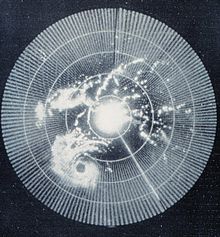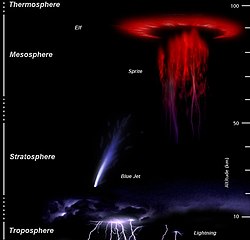Atmospheric physics
 |
| Meteorology |
|---|
| Climatology |
| Aeronomy |
| Glossaries |
Within the
Remote sensing
| Part of a series on |
| Weather |
|---|
|
|

Remote sensing is the small or large-scale acquisition of information of an object or phenomenon, by the use of either recording or real-time sensing device(s) that is not in physical or intimate contact with the object (such as by way of
There are two kinds of remote sensing. Passive sensors detect natural radiation that is emitted or reflected by the object or surrounding area being observed. Reflected sunlight is the most common source of radiation measured by passive sensors. Examples of passive remote sensors include film
Remote sensing makes it possible to collect data on dangerous or inaccessible areas. Remote sensing applications include monitoring
Orbital platforms collect and transmit data from different parts of the
Radiation
Atmospheric physicists typically divide radiation into solar radiation (emitted by the sun) and terrestrial radiation (emitted by Earth's surface and atmosphere).
Solar radiation contains variety of wavelengths. Visible light has wavelengths between 0.4 and 0.7 micrometers.[4] Shorter wavelengths are known as the ultraviolet (UV) part of the spectrum, while longer wavelengths are grouped into the infrared portion of the spectrum.[5] Ozone is most effective in absorbing radiation around 0.25 micrometers,[6] where UV-c rays lie in the spectrum. This increases the temperature of the nearby stratosphere. Snow reflects 88% of UV rays,[6] while sand reflects 12%, and water reflects only 4% of incoming UV radiation.[6] The more glancing the angle is between the atmosphere and the sun's rays, the more likely that energy will be reflected or absorbed by the atmosphere.[7]
Terrestrial radiation is emitted at much longer wavelengths than solar radiation. This is because Earth is much colder than the sun. Radiation is emitted by Earth across a range of wavelengths, as formalized in Planck's law. The wavelength of maximum energy is around 10 micrometers.
Cloud physics
Cloud physics is the study of the physical processes that lead to the formation, growth and precipitation of
Atmospheric electricity

Atmospheric electricity is the term given to the electrostatics and electrodynamics of the atmosphere (or, more broadly, the atmosphere of any planet). The Earth's surface, the ionosphere, and the atmosphere is known as the global atmospheric electrical circuit.[9] Lightning discharges 30,000 amperes, at up to 100 million volts, and emits light, radio waves, X-rays and even gamma rays.[10] Plasma temperatures in lightning can approach 28,000 kelvins and electron densities may exceed 1024/m3.[11]
Atmospheric tide
The largest-amplitude atmospheric tides are mostly generated in the troposphere and stratosphere when the atmosphere is periodically heated as water vapour and ozone absorb solar radiation during the day. The tides generated are then able to propagate away from these source regions and ascend into the mesosphere and thermosphere. Atmospheric tides can be measured as regular fluctuations in wind, temperature, density and pressure. Although atmospheric tides share much in common with ocean tides they have two key distinguishing features:
i) Atmospheric tides are primarily excited by the Sun's heating of the atmosphere whereas ocean tides are primarily excited by the Moon's gravitational field. This means that most atmospheric tides have periods of oscillation related to the 24-hour length of the solar day whereas ocean tides have longer periods of oscillation related to the lunar day (time between successive lunar transits) of about 24 hours 51 minutes.[12]
ii) Atmospheric tides propagate in an atmosphere where density varies significantly with height. A consequence of this is that their amplitudes naturally increase exponentially as the tide ascends into progressively more rarefied regions of the atmosphere (for an explanation of this phenomenon, see below). In contrast, the density of the oceans varies only slightly with depth and so there the tides do not necessarily vary in amplitude with depth.
Note that although solar heating is responsible for the largest-amplitude atmospheric tides, the gravitational fields of the Sun and Moon also raise tides in the atmosphere, with the lunar gravitational atmospheric tidal effect being significantly greater than its solar counterpart.[13]
At ground level, atmospheric tides can be detected as regular but small oscillations in surface pressure with periods of 24 and 12 hours. Daily pressure maxima occur at 10 a.m. and 10 p.m. local time, while minima occur at 4 a.m. and 4 p.m. local time. The absolute maximum occurs at 10 a.m. while the absolute minimum occurs at 4 p.m.[14] However, at greater heights the amplitudes of the tides can become very large. In the mesosphere (heights of ~ 50 – 100 km) atmospheric tides can reach amplitudes of more than 50 m/s and are often the most significant part of the motion of the atmosphere.
Aeronomy

Aeronomy is the science of the upper region of the atmosphere, where dissociation and ionization are important. The term aeronomy was introduced by Sydney Chapman in 1960.
Centers of research
In the UK, atmospheric studies are underpinned by the
See also
|
|
|
References
- ^ COMET program (1999). Remote Sensing. Archived 2013-05-07 at the Wayback Machine University Corporation for Atmospheric Research. Retrieved on 2009-04-23.
- ^ Glossary of Meteorology (2009). Radar. American Meteorological Society. Retrieved on 2009-24-23.
- ^ NASA (2009). Earth. Archived 2006-09-29 at the Wayback Machine Retrieved on 2009-02-18.
- ^ Atmospheric Science Data Center. What Wavelength Goes With a Color? Archived 2011-07-20 at the Wayback Machine Retrieved on 2008-04-15.
- ^ Windows to the Universe. Solar Energy in Earth's Atmosphere. Archived 2010-01-31 at the Wayback Machine Retrieved on 2008-04-15.
- ^ a b c University of Delaware. Geog 474: Energy Interactions with the Atmosphere and at the Surface. Retrieved on 2008-04-15.
- ^ Wheeling Jesuit University. Exploring the Environment: UV Menace. Archived August 30, 2007, at the Wayback Machine Retrieved on 2007-06-01.
- ^ Oklahoma Weather Modification Demonstration Program. CLOUD PHYSICS. Archived 2008-07-23 at the Wayback Machine Retrieved on 2008-04-15.
- ^ Dr. Hugh J. Christian and Melanie A. McCook. Lightning Detection From Space: A Lightning Primer. Archived April 30, 2008, at the Wayback Machine Retrieved on 2008-04-17.
- ^ NASA. Flashes in the Sky: Earth's Gamma-Ray Bursts Triggered by Lightning. Retrieved on 2007-06-01.
- ^ Fusion Energy Education.Lightning! Sound and Fury. Archived 2016-11-23 at the Wayback Machine Retrieved on 2008-04-17.
- ^ Glossary of Meteorology. Atmospheric Tide. Retrieved on 2008-04-15.
- ^ Scientific American. Does the Moon have a tidal effect on the atmosphere as well as the oceans?. Retrieved on 2008-07-08.
- ^ Dr James B. Calvert. Tidal Observations. Retrieved on 2008-04-15.
- ISBN 978-0-387-87824-9)
Further reading
- J. V. Iribarne, H. R. Cho, Atmospheric Physics, D. Reidel Publishing Company, 1980.
External links
 Media related to Atmospheric physics at Wikimedia Commons
Media related to Atmospheric physics at Wikimedia Commons
